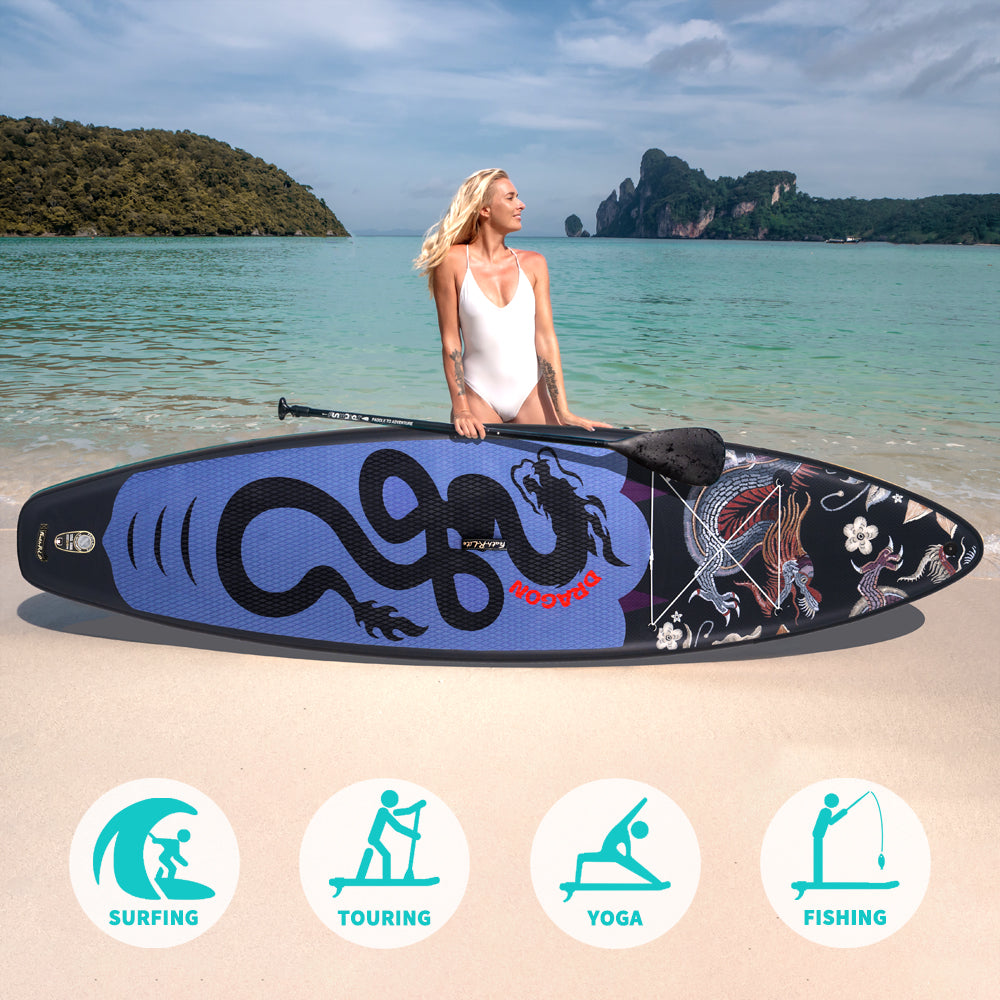
Differences Between Paddleboards and Traditional Surfboards: A Comprehensive Analysis to Help You Choose the Right Gear
Introduction
In the vast world of water sports, surfing has long captivated enthusiasts with its unique charm. As the sport evolves, paddleboards (SUP, Stand-up Paddleboarding) and traditional surfboards have become favorites among water adventurers. But what exactly sets them apart? Whether you’re a novice eager to ride the waves or a seasoned player looking to upgrade your gear, understanding these differences is crucial. It will help you select the perfect water sports equipment to embark on an unforgettable aquatic journey.
I. Differences in Appearance and Design
1. Size
Paddleboards are generally longer and wider than traditional surfboards. Typically, they range from 9 to 14 feet in length and 24 to 36 inches in width. This larger size provides more standing space and better stability, making them ideal for beginners, yoga enthusiasts, or those planning long-distance cruises.
In contrast, traditional surfboards vary significantly in size. Shortboards usually measure 5’6” to 7’6” and are designed for quick, agile maneuvers in tall, steep waves, suited for experienced surfers. Longboards, on the other hand, are longer (over 9 feet) with moderate width and thickness, balancing stability and maneuverability—great for beginners and longboard-style surfers.
2. Shape and Contour
Paddleboards have a relatively boxy shape, with a wide front and a narrower but still broad tail. This design minimizes water resistance, allowing easy gliding on calm waters.
Traditional surfboards come in more diverse shapes. Shortboards have a compact轮廓 (contour) with pointed or swallow tails, enabling rapid turns and flexible movements on waves. Longboards feature a rounder contour with smooth transitions between the front and tail, prioritizing stability and a fluid gliding experience.
3. Thickness
Paddleboards are thicker, typically 4 to 6 inches. The extra thickness increases buoyancy, supporting more weight and accommodating users of all body types, as well as extra gear like fishing tackle for paddleboard fishing.
Traditional surfboards vary in thickness by type. Shortboards are thinner (2.5 to 3.5 inches) to reduce wave resistance and enhance maneuverability. Longboards are 3 to 4 inches thick, balancing buoyancy with smooth gliding.
II. Differences in Function and Purpose
1. Suitable Waters
Paddleboards are highly versatile. They work in calm inland waters (lakes, rivers, bays) for serene cruises and scenic exploration, and can also handle small waves, offering beginners a safe, accessible surfing experience.
Traditional surfboards are primarily designed for ocean waves, especially those with height and power. Shortboards excel in tall, steep waves (e.g., famous spots in Hawaii), where surfers perform advanced moves like cutbacks and aerial spins. Longboards thrive in slower, longer waves (e.g., parts of Australia’s Gold Coast), allowing elegant cross-stepping and extended rides.
2. Movement Style
Paddleboards are propelled by paddling, engaging full-body muscles (arms, shoulders, back, core) while letting users control direction and speed freely. They’re also ideal for water yoga or meditation, offering a unique leisure experience.
Traditional surfboards rely on wave power. Surfers paddle prone to catch waves, then stand up and use weight shifts to ride—demanding wave预判 (prediction), timing, and balance, with higher physical and experiential requirements.
3. Gear-Carrying Capacity
Paddleboards’ size and buoyancy make them great for carrying gear. Fishing enthusiasts can mount rod holders and bait boxes, while long-distance travelers can pack tents or sleeping bags for water-based camping.
Traditional surfboards prioritize wave performance, with limited space for gear. While some longboards hold small items, they can’t match paddleboards for carrying heavy loads.
III. Learning Difficulty and Skill Requirements
1. Balance Difficulty
Paddleboards’ large size and width make balancing easier. Beginners quickly find their footing on calm waters, and even in light winds, stability reduces falling risks.
Traditional surfboards, especially shortboards, demand exceptional balance. Their small size and need for rapid wave adjustments require extensive practice. Longboards are more stable but still harder to balance on waves than paddleboards.
2. Paddling Techniques
Paddleboarding uses straightforward paddling: rhythmic strokes on one side propel the board, with direction controlled by adjusting stroke position and angle. Even newcomers master basics quickly.
Traditional surfing involves complex prone paddling to build speed before catching waves, with stroke strength, frequency, and rhythm adapting to wave conditions. On the wave, turns rely on body rotation and weight shifts—vastly different from paddleboarding.
3. Wave Reading Skills
Paddleboarders in small waves need basic wave awareness but focus more on water conditions (currents, wind) for safety.
Traditional surfers must expertly judge wave height, period, shape, and peak position to catch waves at the right moment. Steep waves require quick stands, while slow waves demand sustained speed—skills honed over time.
IV. Price and Cost Differences
1. Initial Purchase Price
Paddleboards range widely: entry-level models (HDPE or inflatable) cost $200–$500, while premium carbon fiber options exceed $1,000.
Traditional surfboards vary by type: entry-level shortboards cost $300–$800, longboards $500–$1,000, and professional models (top brands, high-end materials) reach thousands of dollars.
2. Maintenance Costs
Paddleboards are low-maintenance: inflatables deflate, clean, and store easily; hardboards need occasional scratch/crack checks and repairs.
Traditional surfboards require more care: hardboards need regular waxing to maintain traction, and wood boards need防潮 (moisture protection) to prevent warping. Repairs and upkeep demand expertise and tools, raising costs.
V. Conclusion: Choosing the Right Board
By comparing design, function, skill needs, and costs, you can now decide between paddleboards and traditional surfboards. Consider these factors:
• Skill Level: Paddleboards suit beginners for easy learning; experienced surfers may prefer shortboards for advanced moves.
• Target Waters: Paddleboards dominate calm inland waters; traditional boards excel in ocean waves.
• Goals: Paddleboards fit fitness, leisure, or yoga; traditional boards offer high-energy surfing.
• Budget: Entry-level options work for limited budgets, while premium gear caters to performance seekers.
Ready to start your water adventure? Do you prefer paddleboards’ versatility or traditional surfboards’ excitement? Share your thoughts!